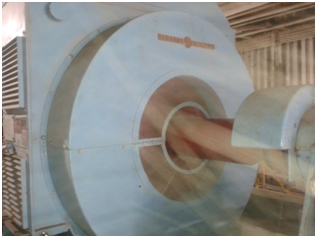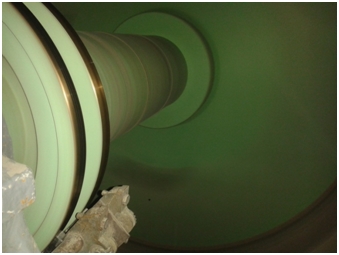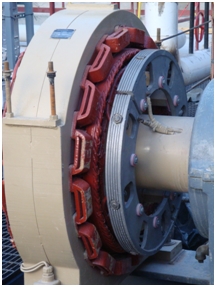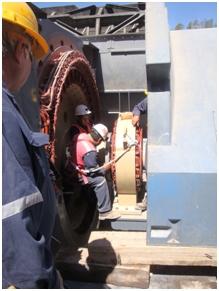If either your industrial operations already use synchronous motors or if you are designing a new industrial process that could greatly benefit from the perks of a synchronous motor, probably you have given some thought about the guts of this type of motor.
Now let one of our fellow members of the community D.Ros tell you more about it. Enjoy!

Synchronous motor
As any electromechanical element, synchronous motor’s performance is greatly defined by good equipment specification and maintenance. However, you’ll recall that, different from any alternating current (AC) asynchronous machine, synchronous motors require direct current (DC) to be supplied to its fields’ windings.
Perhaps the first thing that then popped up into your mind was a conventional set of slip rings mounted directly on the motor’s shaft and some high maintenance carbon brushes, and maybe just then, aware of the disadvantage that having slip rings can be with the hassle of their high maintenance, you might have reconsidered not using synchronous motors any more.

Synchronous motor’s slip rings
Yet, since these motors have been the heart of many heavy duty industrial operations, much attention has been given to optimize its performance by adapting its electrical and mechanical architecture to its applications and easing its maintenance. That’s how they came up with a brushless field exciter (yes, you read it just fine —brushless—).
This brushless exciter works like an alternator, which basically is a generator with a rotating armature mechanically coupled to the shaft of the motor and a stationary field. So, instead of directly supplying DC current into the synchronous motor’s field windings, DC current is supplied to the alternator’s stationary field, which magnetically induces the alternator’s rotating armature, whose energy is then electrically transferred into the field windings of the synchronous motor.

Synchronous motor’s brushless exciter
Now you’re possibly thinking “but didn’t a synchronous motor’s field need DC to be supplied to develop the magnetic poles on its rotor and chase the alternating three phase current on its stator?” and you’re right, but that is where some power electronics kicks in, as part of the mechanical assembly of the alternator, a set of diodes are arranged into a three phase rectifier that converts the induced AC from the three phase windings into DC.
And then some silicone rectifiers (SCRs) are trigger to electrically connect the rectifying bridge’s output into the synchronous motor’s field windings at the optimal moment; ain’t that genius?
This technological development expanded the applications of synchronous motors into highly abrasive processes and explosive risk environments.

Retrofitting a synchronous motor with a brushless field exciter
Furthermore, this technology can be retrofitted into existing slip ring synchronous motors. In conclusion, if the application demands a low maintenance and highly reliable motor drive, a synchronous motor with a brushless exciter will probably be worth the investment.
by D.Ros.
Thanks for sharing your knowledge D.Ros! What did you all think about his article? Let him know in the comment section.
Nice article!
Do you happen to know if AC-supplied exciters are in any widespread use?
I mean that if the stator of the exciter is supplied with a DC source, it obviously won’t excite anything at zero speed right? Thus, the motor is not very suitable for any applications where loaded starting is required.
On the other hand, it doesn’t seem like a big investment to supply the exciter with a small frequency converter, adjusting the voltage and frequency based on the main machine speed and load.
Just curious,
Antti
Hi Antti,
Sorry for getting back so late; been really busy.
AC-supplied exciters are in widespread use mainly for medium and larger sized motors, however the principle of operation of the synchronous machine is still the same, so the AC supplied to the exciter is rectified through brushes and slip rings to inject DC to the rotor’s windings and generate the field required for the rotor to follow the stator’s alternating field.
As you point out, at zero speed it wouldn’t make sense for any current to be supplied to the rotor’s windings. Yet during start-up the stator’s current induces a small field in the rotor that turns out in the intial rotation of the motor without any torque built up. So this type of motor is not suited for loaded startup applications. Usually this type of motors are used with a mechanical clutch system that hook ups the load when the motor has been correctly started; and even sometimes, the rotor’s field is overexcited to be able to withstand the mechanical effort transient in the clutching execution. For application where there’s no clutch, usually slip rings are preferred, typically supplying DC; however AC with an alternator design might be also be used or found in the field.
As per your last inquiry, keep in mind that the synchronous motor’s working principle relies on the catching up of a static field (rotor) with a dynamic (rotating) field (stator), so a small frequency converter wouldn’t add any value. What I’ve seen in the field is sometimes a change on speed is needed and then a really hefty investment needs to be done to furnish a VFD for the stator (typically very high ampacity). Just then, as you might imagine, the field exciter doesn’t require to be that versatile and might just be a static DC supply. The only time I’ve seen this happen was because the process equipment, a ball mill for mineral processing, was designed in Canda for a 50 Hz power line and when it was installed in Mexico, the 60 Hz power line caused the mill to under perform considerably, so there was no alternative than to install a more than a 1000 amp VFD.
Regards,
Dante
Hi Dante,
and no worries! I guess we all get to know what busy means, every now and then.
And thanks a lot for the comprehensive answer!
Best,
Antti